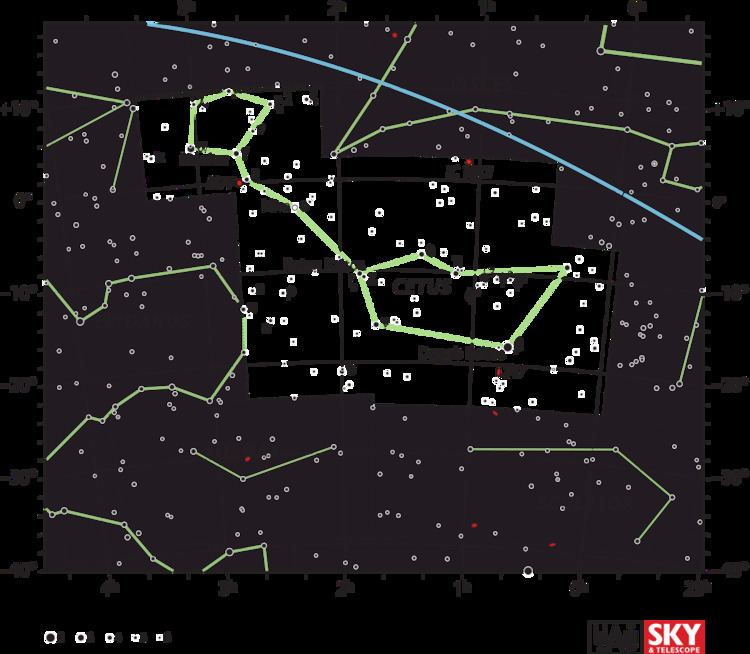ARICNS data Rotation 9.2 days Apparent magnitude (V) 4.84 | Magnitude 4.84 | |
 | ||
People also search for 1 Ceti, Xi1 Ceti, Nu Ceti, Chi Ceti | ||
Kappa1 Ceti (κ1 Cet, κ1 Ceti) is a yellow dwarf star approximately 30 light-years away in the equatorial constellation of Cetus. The star was discovered to have a rapid rotation, roughly once every nine days. Though there are no extrasolar planets confirmed to be orbiting the star, Kappa1 Ceti is considered a good candidate to contain terrestrial planets (like the Earth). The system is a candidate binary star, but has not been confirmed. The star should not be confused with the star Kappa2 Ceti, which is ten times as distant.
Contents
Stellar components
Kappa1 Ceti is a yellow dwarf star of the spectral type G5Ve. Since 1943, the spectrum of this star has served as one of the stable anchor points by which other stars are classified. The star has roughly the same mass as the Sun, with 95% of the Sun's radius but only 85 percent of the luminosity. It is unclear whether the star is equal or is more enriched in elements heavier than hydrogen, but it is determined that the star has between 98 and 240 percent of the Sun's abundance of iron. Kappa1 Ceti is much younger than the Sun, and may only be around 800 million years old.
The rapid rotation rate of this star, approximately once every nine days, is indicative of a relatively youthful body several hundred million years in age. Due to starspots, the star varies slightly over the approximately the same period. The variations in period are thought to be caused by differential rotation at various latitudes, similar to what happens on the surface of the Sun. The star spots on Kappa1 Ceti range in latitude from 10° to 75° The magnetic properties of this star make it "an excellent match for the Sun at a key point in the Earth's past".
According to recent hypotheses, unusually intense stellar flares from a solar twin star could be caused by the interaction of the magnetic field of a giant planet in tight orbit with that star's own magnetic field. Some Sun-like stars of spectral class F8 to G8 have been found to undergo enormous magnetic outbursts to produce so-called superflares (coronal mass ejections) that release between 100 and 10 million times more energy than the largest flares ever observed on the sun, making them brighten briefly by up to 20 times. In 1998, nine Solar twin stars (including Kappa1 Ceti) were observed to have produced superflares, on average, about once per century. None of these stars rotate particularly fast, have close binary companions, or are very young. Previously, such large flares had not been observed in solar-type main sequence stars, although they are common in a group of dim main-sequence, reddish M dwarfs known as flare stars.
The space velocity components of this star are (U, V, W) = (−22.41, −4.27, −5.32) km/s. It is not known to be a member of a moving group of stars.
Possible planetary system
Using the radial velocity technique, the search for substellar companions has thus far failed to find a brown dwarf or extrasolar planet in the "hot zone" orbit around Kappa1 Ceti. Given the regular eruption of superflares, however, it is unlikely that Earth-type life could survive for long on any inner terrestrial planet. The distance from the star where an Earth-type planet (with liquid water) would be stable is centered on 0.92 astronomical units from the star (between the orbital distances of Earth and Venus in the Solar system). At this distance, such a planet would have an orbital period of almost 324 days.
